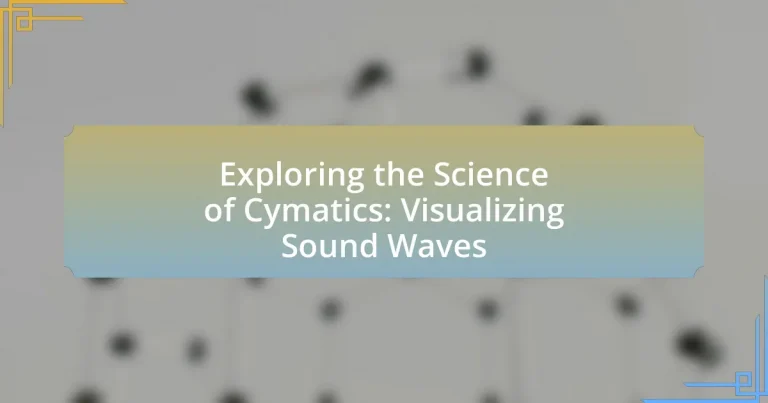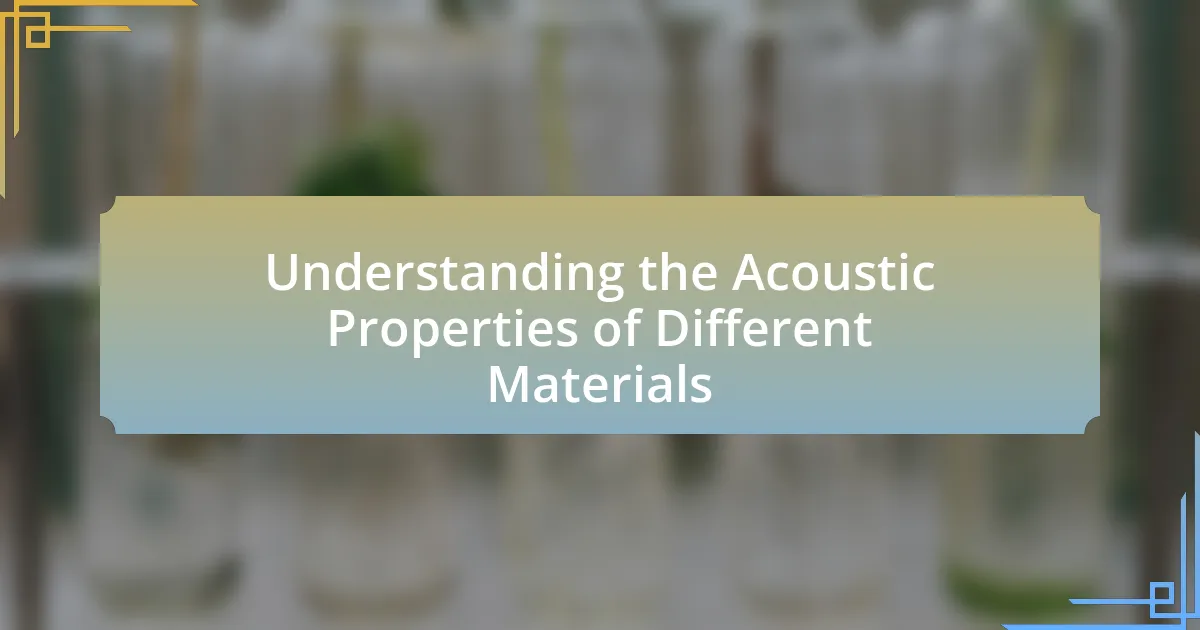Cymatics is the scientific study of visible sound and vibration, illustrating how sound waves create patterns in various mediums, such as liquids and solids. The article explores the principles of cymatics, detailing how sound waves are visualized through techniques involving mediums like sand and water, and the impact of different frequencies on pattern formation. It also highlights historical contributions from pioneers like Ernst Chladni and Hans Jenny, modern applications in fields such as music therapy and art, and the underlying physical principles governing sound wave behavior. Additionally, the article provides insights into conducting cymatic experiments at home, emphasizing the relationship between sound waves and resonance.

What is Cymatics and How Does It Relate to Sound Waves?
Cymatics is the study of visible sound and vibration, demonstrating how sound waves can create patterns in a medium, typically a liquid or a solid. This phenomenon occurs when sound waves interact with a surface, causing it to vibrate and form geometric shapes that correspond to the frequency of the sound. For example, when a plate covered with sand is vibrated at specific frequencies, the sand arranges itself into intricate patterns, illustrating the relationship between sound waves and physical form. Research by Hans Jenny in the 1960s provided foundational insights into cymatics, showing that different frequencies produce distinct patterns, thereby confirming the connection between sound waves and visual representations.
How are sound waves visualized in Cymatics?
Sound waves are visualized in Cymatics by using a medium, such as sand or liquid, that responds to sound frequencies. When sound vibrations are applied to the medium, they create patterns that correspond to the frequency and amplitude of the sound waves. For example, when a speaker emits a specific frequency, the particles in the medium arrange themselves into distinct geometric shapes, demonstrating the relationship between sound and physical form. This phenomenon has been documented in various studies, including those by Hans Jenny, who pioneered Cymatics in the 1960s, illustrating how different frequencies produce unique visual patterns.
What techniques are used to create visual representations of sound?
Techniques used to create visual representations of sound include cymatics, oscilloscopes, and spectrograms. Cymatics involves using a medium like sand or liquid that vibrates in response to sound frequencies, forming visible patterns. Oscilloscopes graphically display sound waves as waveforms, allowing for real-time visualization of audio signals. Spectrograms analyze sound frequencies over time, producing a visual representation that shows the intensity of different frequencies. These methods are validated by their application in scientific research and audio engineering, demonstrating their effectiveness in visualizing sound.
How do different frequencies affect the patterns produced?
Different frequencies produce distinct patterns in cymatics due to the varying wavelengths and energy levels associated with each frequency. Higher frequencies create more intricate and complex patterns, while lower frequencies tend to generate simpler, broader shapes. For instance, experiments conducted by Hans Jenny, a pioneer in cymatics, demonstrated that when sound waves of different frequencies are applied to a medium like sand or water, the resulting geometric patterns vary significantly; frequencies around 100 Hz often yield circular shapes, while frequencies above 1000 Hz can produce detailed, fractal-like designs. This relationship between frequency and pattern formation illustrates the fundamental principles of wave behavior and resonance in physical mediums.
Why is Cymatics important in the study of sound?
Cymatics is important in the study of sound because it visually demonstrates how sound waves interact with matter, revealing the patterns and structures created by different frequencies. This visual representation allows researchers to understand the physical properties of sound, such as resonance and wave propagation. Studies have shown that specific frequencies can create distinct geometric patterns in mediums like sand or water, illustrating the relationship between sound and physical form. For example, experiments conducted by Hans Jenny in the 1960s showcased how varying sound frequencies produced unique shapes in a vibrating plate covered with sand, providing concrete evidence of sound’s influence on matter.
What insights does Cymatics provide into the nature of sound?
Cymatics provides insights into the nature of sound by visually demonstrating how sound waves interact with matter. Through experiments that involve vibrating surfaces covered with substances like sand or water, Cymatics reveals that sound can create distinct patterns and shapes, illustrating the concept that sound is not merely an auditory phenomenon but also a physical force that influences the environment. These patterns, which vary based on frequency and amplitude, serve as evidence that sound waves can organize matter into complex structures, thereby enhancing our understanding of sound’s impact on physical forms.
How can Cymatics influence our understanding of music and acoustics?
Cymatics can significantly enhance our understanding of music and acoustics by visually demonstrating how sound waves interact with different mediums. This visual representation allows researchers and musicians to observe the patterns and structures formed by sound frequencies, revealing the relationship between sound and physical form. For instance, experiments conducted by Hans Jenny in the 1960s showed that various frequencies create distinct geometric patterns in substances like sand and water, illustrating how sound can shape matter. This insight helps in comprehending how sound influences environments and can be applied in fields such as music therapy, acoustical engineering, and sound design, thereby bridging the gap between auditory experiences and their physical manifestations.

What are the Historical Context and Applications of Cymatics?
Cymatics, the study of visible sound and vibration, has historical roots dating back to the 18th century, notably with the work of Ernst Chladni, who demonstrated how sound waves could create patterns in sand on vibrating plates. This foundational research laid the groundwork for further exploration into the relationship between sound and physical forms. In contemporary applications, cymatics is utilized in various fields, including music therapy, where sound frequencies are believed to influence emotional and physical well-being, and in art, where visual representations of sound waves inspire creative expression. Additionally, cymatics has implications in scientific research, particularly in understanding wave phenomena and resonance in materials.
Who were the pioneers in the field of Cymatics?
The pioneers in the field of Cymatics include Ernst Chladni, who is often referred to as the father of acoustics, and Hans Jenny, who significantly advanced the study of sound and its visual representations. Chladni’s experiments in the late 18th century involved using vibrating plates covered with sand to visualize sound patterns, establishing foundational principles in acoustics. Hans Jenny, in the 20th century, expanded on Chladni’s work by using various materials and techniques to create intricate patterns, further demonstrating the relationship between sound and physical forms. Their contributions laid the groundwork for understanding how sound waves can influence matter visually.
What experiments did early researchers conduct to explore sound visualization?
Early researchers conducted experiments using various mediums to visualize sound waves, notably through the work of Ernst Chladni in the 18th century. Chladni created patterns on metal plates covered with sand by bowing the edges, which caused the sand to move and form distinct geometric shapes corresponding to different frequencies. This method demonstrated the relationship between sound vibrations and visual patterns, laying the groundwork for the field of cymatics. Additionally, Hans Jenny expanded on Chladni’s work in the 20th century by using liquids and powders to visualize sound, further illustrating how sound waves can create complex visual forms.
How has the understanding of Cymatics evolved over time?
The understanding of Cymatics has evolved from early observations of sound-induced patterns to a more scientific exploration of the relationship between sound and physical forms. Initially, in the 19th century, Ernst Chladni demonstrated that sound vibrations could create visible patterns in sand on vibrating plates, laying the groundwork for Cymatics. In the 20th century, Hans Jenny expanded on Chladni’s work, coining the term “Cymatics” and conducting experiments that illustrated how different frequencies produced distinct shapes in various materials, such as liquids and powders. Recent advancements in technology have allowed for more precise visualizations of sound waves, enabling researchers to explore the implications of Cymatics in fields like acoustics, biology, and even art. This progression reflects a shift from anecdotal evidence to empirical research, highlighting the intricate connections between sound and matter.
What are the modern applications of Cymatics?
Modern applications of Cymatics include therapeutic practices, artistic expression, and scientific research. In therapeutic settings, Cymatics is utilized in sound healing, where specific frequencies are believed to promote physical and emotional well-being. Artists employ Cymatics to create visual representations of sound, enhancing multimedia art installations. Additionally, researchers study Cymatics to understand wave phenomena in various fields, including acoustics and material science, demonstrating its relevance in both practical and theoretical contexts.
How is Cymatics used in art and design?
Cymatics is used in art and design to visually represent sound waves through patterns created by vibrating materials. Artists and designers utilize cymatic techniques to create intricate visual displays that reflect the frequencies and vibrations of sound, often employing mediums like sand, water, or other substances that respond to sound waves. For instance, when sound frequencies are applied to a surface covered with sand, distinct geometric patterns emerge, illustrating the relationship between sound and visual form. This phenomenon has been documented in various artistic projects, such as those by artist Ernst Chladni, who is known for his pioneering work in the 18th century that demonstrated how sound vibrations could create visible patterns.
What role does Cymatics play in scientific research and education?
Cymatics plays a significant role in scientific research and education by providing a visual representation of sound waves, which enhances understanding of wave phenomena. This visualization aids in various fields, including physics, acoustics, and art, allowing students and researchers to observe the effects of sound frequencies on different materials. For instance, studies have shown that cymatic patterns can illustrate the relationship between frequency and physical form, as demonstrated in experiments where sand or liquids form distinct shapes when subjected to sound vibrations. This empirical evidence supports the educational value of cymatics in demonstrating complex scientific concepts in a tangible manner.

What are the Scientific Principles Behind Cymatics?
Cymatics is based on the scientific principles of wave phenomena, particularly how sound waves interact with matter. When sound waves travel through a medium, such as a liquid or a solid, they create patterns based on the frequency and amplitude of the sound. These patterns are visible when a medium, like sand or water, is vibrated at specific frequencies, causing the particles to arrange themselves into geometric shapes. Research by Hans Jenny in the 1960s demonstrated that different frequencies produce distinct patterns, illustrating the relationship between sound and physical form. This phenomenon is explained by the principles of resonance and standing waves, where certain frequencies resonate with the medium, leading to stable patterns that can be observed visually.
How do sound waves interact with different materials in Cymatics?
Sound waves interact with different materials in Cymatics by causing them to vibrate and form distinct patterns based on the frequency and amplitude of the sound. When sound waves travel through a medium, such as sand, water, or a membrane, they create areas of compression and rarefaction, leading to the formation of geometric shapes and patterns that visually represent the sound’s characteristics. For example, when a speaker emits sound waves into a plate covered with sand, the vibrations cause the sand to move and settle into specific patterns, which vary with different frequencies. This phenomenon has been documented in studies, such as those by Ernst Chladni in the 18th century, who demonstrated that different frequencies produce unique patterns on vibrating plates, illustrating the relationship between sound and material interaction.
What materials are commonly used in Cymatic experiments?
Cymatic experiments commonly utilize materials such as water, sand, and various types of powders. Water serves as a medium to visualize sound waves through surface tension and vibration patterns, while sand and powders like cornstarch or salt are used on vibrating plates to create distinct geometric shapes when exposed to sound frequencies. These materials effectively demonstrate the principles of sound wave propagation and resonance, as evidenced by the clear patterns formed in response to different frequencies.
How do these materials influence the resulting patterns?
Materials significantly influence the resulting patterns in cymatics by determining how sound waves interact with their surfaces. Different materials, such as sand, water, or powders, exhibit unique physical properties that affect the vibration frequencies and modes, leading to distinct visual patterns. For instance, when sound waves pass through a medium like water, the surface tension and viscosity create intricate wave formations, while granular materials like sand form geometric shapes based on their particle size and distribution. Studies have shown that the frequency and amplitude of sound waves, combined with the material’s characteristics, dictate the complexity and symmetry of the resulting patterns, as evidenced by experiments demonstrating that varying the material alters the visual output significantly.
What are the physical principles governing sound wave behavior?
The physical principles governing sound wave behavior include the concepts of wave propagation, frequency, amplitude, and the medium through which sound travels. Sound waves are mechanical waves that require a medium, such as air, water, or solids, to propagate. The speed of sound varies depending on the medium; for example, sound travels faster in water than in air due to the closer molecular arrangement in liquids.
Frequency determines the pitch of the sound, while amplitude relates to the loudness. According to the wave equation, the speed of sound (v) is equal to the product of frequency (f) and wavelength (λ), expressed as v = f × λ. This relationship illustrates how changes in frequency or wavelength affect sound propagation. Additionally, sound waves exhibit behaviors such as reflection, refraction, and diffraction, which are governed by the principles of wave mechanics. These principles are foundational in understanding phenomena like cymatics, where sound waves create visual patterns in a medium.
How do frequency and amplitude affect sound wave propagation?
Frequency and amplitude significantly influence sound wave propagation. Frequency determines the pitch of the sound; higher frequencies result in higher pitches, while lower frequencies produce lower pitches. Amplitude affects the loudness of the sound; greater amplitudes lead to louder sounds, and smaller amplitudes result in softer sounds.
Research indicates that sound waves travel through different mediums at varying speeds, influenced by both frequency and amplitude. For instance, in air, sound travels faster at higher frequencies due to reduced wavelength, while amplitude affects the energy carried by the wave, impacting how far the sound can travel before dissipating. This relationship is crucial in applications such as acoustics and audio engineering, where understanding sound wave behavior is essential for effective sound design and manipulation.
What is the relationship between sound waves and resonance in Cymatics?
Sound waves and resonance in Cymatics are intrinsically linked, as resonance occurs when sound waves interact with a medium, causing it to vibrate and produce visible patterns. In Cymatics, specific frequencies of sound waves create resonant frequencies in materials like sand or water, leading to distinct geometric shapes and patterns that visually represent the sound. Research by Hans Jenny, a pioneer in Cymatics, demonstrated that different frequencies result in unique patterns, confirming that the relationship between sound waves and resonance is fundamental to visualizing sound phenomena.
How can one experiment with Cymatics at home?
To experiment with Cymatics at home, one can use a shallow dish filled with a fine powder, such as salt or sand, and a speaker to produce sound vibrations. By placing the dish on the speaker and playing different frequencies, the powder will form intricate patterns that visualize the sound waves. This method is supported by the principles of Cymatics, which demonstrate that sound can create visible shapes and structures in a medium.
What materials and equipment are needed for basic Cymatic experiments?
Basic Cymatic experiments require a few essential materials and equipment: a speaker, a shallow dish or container, a medium such as water or sand, and a frequency generator or audio source. The speaker produces sound waves, which interact with the medium in the dish, creating visible patterns. The frequency generator allows for the adjustment of sound frequencies, enabling the observation of different Cymatic patterns. These components are fundamental for demonstrating the principles of Cymatics, as evidenced by numerous experiments that illustrate how sound can influence physical forms in various materials.
What steps should be followed to visualize sound waves effectively?
To visualize sound waves effectively, one should follow these steps: First, select a medium that can respond to sound vibrations, such as water, sand, or a membrane. Next, generate sound waves using a speaker or a tuning fork, ensuring the frequency is appropriate for the chosen medium. Then, observe the patterns formed in the medium, which will visually represent the sound waves. For instance, in water, different frequencies create distinct wave patterns, demonstrating the relationship between sound and visual representation. This method is grounded in the principles of cymatics, which studies how sound frequencies influence physical forms.





